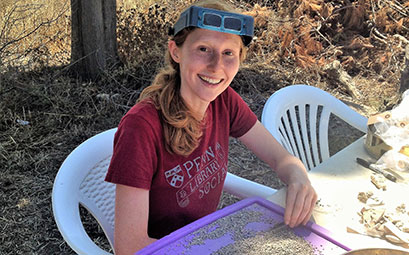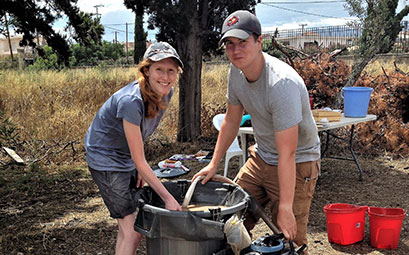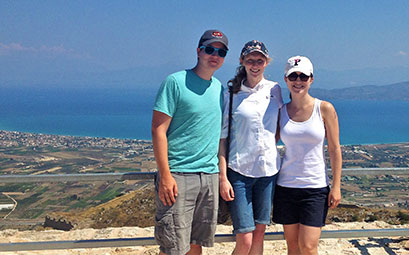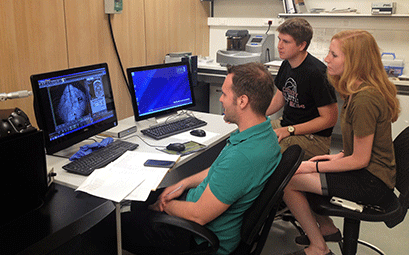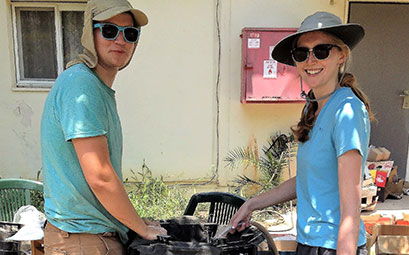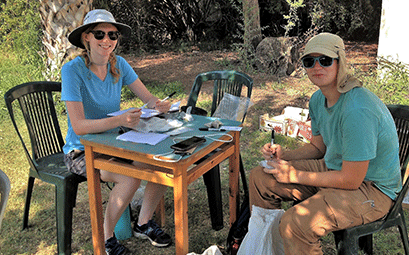Summer Archaeobotany Program
Curatorial Section
Research Discipline
Archaeology
Expand Global Research
Over more than a century, we’ve opened up endless exploration across six continents. New field work endowments will ensure our continued leadership in national and international field research and discovery.
Give Now- Time Period Studied
-
The students participated in the program for seven weeks during June-July 2018. Archaeobotanical research was conducted at the sites of Lechaion in Greece, dating to the Late Roman period (4th - 6th c. CE) and Tel Yaqush in Israel, dating to the Early Bronze Age (ca. 3600 - 2500 BCE).
- Location Information
-
The program began in Greece at the harbor site of Lechaion, which served as one of the main trading ports for the ancient city of Corinth. Afterward, students traveled to Athens to assist in analyzing the plant material recovered from the excavations. The laboratory work took place at the Malcolm H. Wiener Laboratory of Archaeological Science at the American School of Classical Studies in Athens (ASCSA). The students then joined the Penn Museum-sponsored project of Tel Yaqush, a multi-phase agricultural village located in the Jordan Valley in northern Israel, to design an archaeobotanical recovery strategy for the excavation.
- Researcher(s)
-
- Chantel White, Project Director, Teaching Specialist for Archaeobotany, Center for the Analysis of Archaeological Materials (CAAM)
- Elizabeth Coulter (Biology, ’18), Penn Undergraduate Team Member
- Kevin McKain (Temple Anthropology, ’18), Penn Museum Volunteer Team Member
- Alexandria Mitchem (Penn Anthropology, ’16), current graduate student at Columbia University
- Fabian Toro (Penn Chemical Engineering, ’17), current graduate student at the University of California – San Diego
- Emily Dawson (MA, University of Chicago) current graduate student at the University of Texas – Austin
- Project Summary
-
Plant remains are some of the most fragile materials recovered from archaeological sites, but under the right conditions ancient seeds, nut shell, and wood can survive for thousands of years. Most of the plant remains found at archaeological sites are “carbonized”, or charred, after being burned in house fires and cooking fires. The nutrients within these charred plant remains are burned away, so they are no longer attractive to the rodents, insects, and bacteria which typically break down organic matter over time. The seeds and other plant parts found in the archaeological record can provide us with important information about past human diet, available resources, and the environments in which people lived.
At the Center for the Analysis of Archaeological Materials (CAAM), undergraduate and graduate students learn how to analyze and identify plant remains in courses such as ANTH 440 Plants and Society and ANTH 433 Archaeobotany Seminar. However, coursework and lab-based research is only the tip of the iceberg for CAAM. One of the most important things we do is teach our students that archaeological science does not just take place in a laboratory setting. It is incredibly important to understand archaeological context and participate in field excavations. Working in these different settings gives students a first-hand look at how projects operate and teaches them how to think on their feet – how to decide on best-practice sampling and processing methods for a given archaeological site.
During the Summer Archaeobotany Program, students had the unique opportunity to participate in excavations at two very different archaeological sites: Lechaion, the harbor of ancient Corinth in Greece, and Tel Yaqush, a 5,000-year-old Early Bronze Age site in Israel. Our work focused on recovering plant remains from these archaeological deposits using a technique known as flotation. This technique involves building a flotation tank, which is a tank filled with clean water. An archaeological sediment sample is collected from the excavation, placed in the tank, and agitated so that the heavy artifacts sink (such as coins, pottery, etc.) and the lighter plant remains float to the surface. All the artifacts are collected, and the plant remains can later be analyzed under a microscope. At the harbor town of Lechaion, we recovered an assemblage of cereals, olive pits, and other daily foods consumed by people who worked at the harbor during the Late Roman period.
Following the excavation at Lechaion, we traveled to the American School of Classical Studies in Athens to study the plant remains in greater detail using the scanning electron microscope housed at the Malcolm H. Wiener Laboratory of Archaeological Science. We were able to identify wood species that were used at the port for shipbuilding and export, including fir timbers. From Athens we then traveled to the Jordan Valley in northern Israel to join the Penn Museum-sponsored archaeological excavations at Tel Yaqush and initiate an archaeobotany program. The students built a flotation system from scratch, processed samples, and recovered hundreds of barley grains. These grains, which likely represent a barley storage feature dating to the earliest phase of the Early Bronze Age, help us understand the nature of agricultural activities in the Jordan Valley and have set the stage for future archaeobotanical work at the site.
After completing the summer program, students are offered the opportunity to continue participating in the analysis and writeup of the archaeobotanical results from these projects. Based on the work carried out at Lechaion harbor, for example, we have coauthored on a paper that was presented at the annual meeting of the Archaeological Institute of America in January 2019.
- Resources & More Information
-
Center for the Analysis of Archaeological Materials (CAAM)
Museum blogpost from previous student participant, Ally Mitchem (2016)
Malcolm H. Wiener Laboratory, ASCSA
To keep up with the latest updates in CAAM research, follow us on twitter.
- Are you a Penn Student interested in participating in the Summer Archaeobotany Program or helping in the CAAM labs?
Each summer, students studying archaeological science in the Center for the Analysis of Archaeological Materials (CAAM) can participate in a summer field program at various archaeological sites in the Mediterranean. Under the guidance of Dr. Chantel White, students learn the fundamentals of sampling, processing, and analyzing plant remains while in the field. In 2018 this seven-week field program included sites in Greece and Israel.
